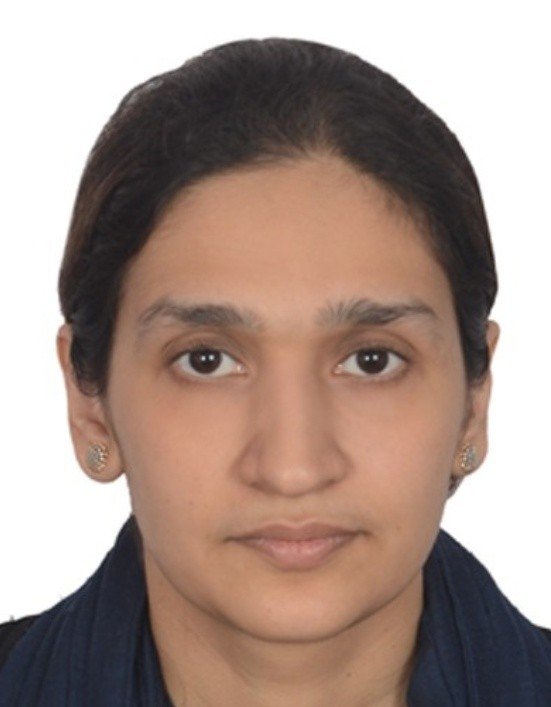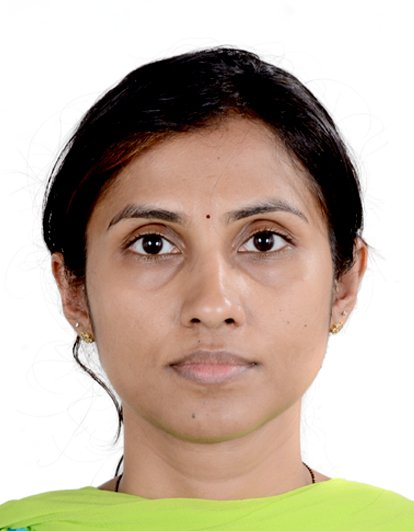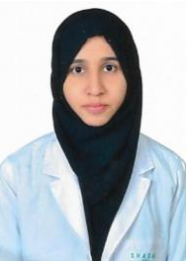
Obstetrics & Gynecology
- Home
- Obstetrics & Gynecology
Over the years, field of Obstetrics and Gynecology has witnessed enormous expansion in clinical and basic data as well as tremendous growth in field related technology. This growth has been because of our day to day effort in each and every medical and post graduate institute. Our Goal and Objectives will be fulfilled further if our young junior doctors and post-graduates follow the same path.
Faculty
| Teaching Staff | |||
| Photo | Name of the Faculty Qualification Registration No. |
Designation | Details |
|---|---|---|---|
 |
Dr. Pabbaraju Padmaja M.B.B.S., M.D - Obstetrics & Gynaecology Reg No: AMC10662 |
Professor & HOD | View Details |
 |
Dr. Ayesha Jehan M.B.B.S., M.D - Obstetrics & Gynaecology Reg No: HMC10921 |
Professor | View Details |
 |
Dr. Anjum Kehkahsan M.B.B.S., M.S - Obstetrics & Gynaecology Reg No: 54137 |
Professor | View Details |
 |
Dr. Surayya Tahseen M.B.B.S., M.S - Obstetrics & Gynaecology Reg No: 72360 |
Associate Professor | View Details |
 |
Dr. T.Deepthi Sri M.B.B.S., D.G.O, DNB - Obstetrics & Gynaecology Reg No: 55759 |
Associate Professor | View Details |
 |
Dr. Juveria Jahangir M.B.B.S., M.S - Obstetrics & Gynaecology Reg No: 72832 |
Assistant Professor | View Details |
 |
Dr. N. Chaitanya M.B.B.S., D.G.O, DNB - Obstetrics & Gynaecology Reg No: 56504 |
Assistant Professor | View Details |
 |
Dr. Zareena Sultana M.B.B.S., D.G.O, DNB - Obstetrics & Gynaecology Reg No: 46691 |
Assistant Professor | View Details |
 |
Dr. Fatima Mehnaz Naghma M.B.B.S., M.S - Obstetrics & Gynaecology Reg No: TSMC/FMR/00530 |
Assistant Professor | View Details |
 |
Dr. Sadula Shravya M.B.B.S., DNB - Obstetrics & Gynaecology Reg No: APMC/FMR/91629 |
Assistant Professor | View Details |
 |
Dr. Preeti Banerjee M.B.B.S., DNB - Obstetrics & Gynaecology Reg No: TSMC/FMR/11722 |
Assistant Professor | View Details |
 |
Dr. P Pragnia M.B.B.S., M.D - Obstetrics & Gynaecology, M.CH. Gynaecologic Oncology Reg No: 66923 |
Assistant Professor | View Details |
 |
Dr. B. Mounika Reddy M.B.B.S., D.G.O, DNB - Obstetrics & Gynaecology Reg No: APMC/FMR/85712 |
Assistant Professor | View Details |
 |
Dr. Juveriya M.B.B.S., M.S - Obstetrics & Gynaecology Reg No: TSMC/FMR/07016 |
Senior Resident | View Details |
 |
Dr. Shwetha H M.B.B.S., M.S - Obstetrics & Gynaecology Reg No: APMC/FMR/90411 |
Senior Resident | View Details |
 |
Dr. Farhath Unnisa M.B.B.S., DNB - Obstetrics & Gynaecology Reg No: TSMC/FMR/06712 |
Senior Resident | View Details |
 |
Dr. Sumera Neha M.B.B.S., DNB - Obstetrics & Gynaecology Reg No: TSMC/FMR/07589 |
Senior Resident | View Details |
 |
Dr. Ayushi Arun Shastry M.B.B.S. Reg No: 2018084053 |
Senior Resident | View Details |
 |
Dr. Ayesha Fathima M.B.B.S., M.S - Obstetrics & Gynaecology Reg No: ANP20180001602ktk |
Senior Resident | View Details |
 |
Dr. Nudrat Tazeen Rehan Momin M.B.B.S., Diploma in Obstetrics & Gynaecology Reg No: TSMC/FMR/14693 |
Senior Resident | View Details |
| Non-Teaching Staff | ||
| Name | Designation | |
|---|---|---|
Achievments & Recognitions
Publications
2024
Tahseen, Surayya; Juveriya,; Younus, Hafsa; Safiya, Amtul Aziz; Sumain, Sofia; Hafeez, Asma
Compare the anti-hypertensive efficacy of oral labetalol and oral nifedipine in mild preecclampsia Journal Article
In: International Journal of Medicine and Public Health, vol. 14, iss. 1, pp. 356-364, 2024, ISSN: 2230–8598.
@article{Tahseen_2024,
title = {Compare the anti-hypertensive efficacy of oral labetalol and oral nifedipine in mild preecclampsia},
author = {Surayya Tahseen and Juveriya and Hafsa Younus and Amtul Aziz Safiya and Sofia Sumain and Asma Hafeez},
url = {https://www.ijmedph.org/Uploads/Volume14Issue1/65.%20[182._IJMEDPH_Jafar]%20356-364.pdf},
doi = {10.5530/ijmedph.2024.1.65},
issn = {2230–8598},
year = {2024},
date = {2024-02-20},
urldate = {2024-02-20},
journal = {International Journal of Medicine and Public Health},
volume = {14},
issue = {1},
pages = {356-364},
abstract = {Background: Aim: This study is to compare the anti-hypertensive efficacy of Tablet Labetalol and Tablet. Nifedipine in mild preeclampsia. Material and Methods: The study was conducted at the Deccan College of
Medical Sciences (Owaisi Hospital and Research Centre and Princess Esra Hospital) both the hospitals attached from January 2021 to June 2022. 100 antenatal women with mild preeclampsia were selected. Informed consent
taken. 50 women were given Tablet Labetalol. 50 women were treated with Tablet Nifedipine. Results: This study was conducted on a total of 100 antenatal mild preeclamptic women to compare the anti-hypertensive efficacy of T. Labetalol and T. Nifedipine. The maternal and fetal outcomes were also studied. Patients were divided into two groups 50 each. Group A Received T. Labetalol and group B received T. Nifedipine. Blood pressure and feto maternal status were serially monitored. Termination was done at 37 completed weeks gestation or when the
patient progressed to severe preeclampsia. The average dose required for T. Labetalol was 300 mg and 30 mg for T. Nifedipine. In both the groups, all 50 patients had adequate control of blood pressure. Inspite of adequate control the disease progressed in both groups. In group A (T. Labetalol) 14% progressed to
severe pre-eclampsia. In group B (T. Nifedipine) 20% progressed to severe pre-eclampsia. Among the babies delivered, in group A 86% were term babies and 8% required SNN admission. In group B 80% were term babies and 10% required SNN admission. Comparing the two groups, group B had significantly higher number of side effects when compared to group A. None of the patients developed grave complications such as HELLP syndrome, pulmonary edema, coagulopathy, postpartum collapse, eclampsia. The maternal mortality was nil.
Thus when patients with preeclampsia are identified and treated atan earlier stage the morbidity and mortality associated with preeclampsia can be significantly reduced. Conclusion: From this study it is prudent that both T. Labetalol and T. Nifedipine are equally efficacious in the control of hypertension in mild preeclampsia.},
keywords = {},
pubstate = {published},
tppubtype = {article}
}
Medical Sciences (Owaisi Hospital and Research Centre and Princess Esra Hospital) both the hospitals attached from January 2021 to June 2022. 100 antenatal women with mild preeclampsia were selected. Informed consent
taken. 50 women were given Tablet Labetalol. 50 women were treated with Tablet Nifedipine. Results: This study was conducted on a total of 100 antenatal mild preeclamptic women to compare the anti-hypertensive efficacy of T. Labetalol and T. Nifedipine. The maternal and fetal outcomes were also studied. Patients were divided into two groups 50 each. Group A Received T. Labetalol and group B received T. Nifedipine. Blood pressure and feto maternal status were serially monitored. Termination was done at 37 completed weeks gestation or when the
patient progressed to severe preeclampsia. The average dose required for T. Labetalol was 300 mg and 30 mg for T. Nifedipine. In both the groups, all 50 patients had adequate control of blood pressure. Inspite of adequate control the disease progressed in both groups. In group A (T. Labetalol) 14% progressed to
severe pre-eclampsia. In group B (T. Nifedipine) 20% progressed to severe pre-eclampsia. Among the babies delivered, in group A 86% were term babies and 8% required SNN admission. In group B 80% were term babies and 10% required SNN admission. Comparing the two groups, group B had significantly higher number of side effects when compared to group A. None of the patients developed grave complications such as HELLP syndrome, pulmonary edema, coagulopathy, postpartum collapse, eclampsia. The maternal mortality was nil.
Thus when patients with preeclampsia are identified and treated atan earlier stage the morbidity and mortality associated with preeclampsia can be significantly reduced. Conclusion: From this study it is prudent that both T. Labetalol and T. Nifedipine are equally efficacious in the control of hypertension in mild preeclampsia.
2023
Jahangir, Juveria; Kehkeshan, Anjum; Yousuf, Summaiyah; Siddiqui, Yusra; Siddiqui, Rana
Study of route of delivery and perinatal outcome in oligohydramnios Journal Article
In: International Journal of Academic Medicine and Pharmacy, vol. 5, iss. 6, pp. 1385-1387, 2023, ISSN: 2687-5365.
@article{Jahangir_2023,
title = {Study of route of delivery and perinatal outcome in oligohydramnios},
author = {Juveria Jahangir and Anjum Kehkeshan and Summaiyah Yousuf and Yusra Siddiqui and Rana Siddiqui},
url = {https://www.academicmed.org/Uploads/Volume5Issue6/285.%20[2114.%20JAMP_Anjum]%201385-1387.pdf},
doi = {10.47009/jamp.2023.5.6.285},
issn = {2687-5365},
year = {2023},
date = {2023-12-31},
journal = {International Journal of Academic Medicine and Pharmacy},
volume = {5},
issue = {6},
pages = {1385-1387},
abstract = {Background: To study neonatal outcome and appropriate route of delivery in oligohydramnios of AFI < 5 cm in women at or beyond 34 weeks gestation. Methods: In this prospective case control study of 50 women (study group) with oligohydramnios of AFI < 5 cm at or beyond 34 weeks of gestation was compared with 50 women (control group) with normal AFI > 5 cm and less than 25 at or beyond 34 weeks matched for age, parity, gestational age. Women with PROM, gestational age < 34 weeks and greater than 40 weeks, congenital anomaly, PIH, multiple gestations were excluded from this study. This study was done in antenatal and intrapartum period for neonatal outcome and appropriate route of delivery. Results: In our study we found that oligohydramnios was associated with increased rate of non-reassuring fetal heart rate (25% Vs 6%), cesarean delivery (50% Vs 10%), low birth weight (60% Vs 25%), FGR (17% Vs 5%) and admission to NICU (15% Vs 5%). There was no neonatal death in the study. Conclusion: Pregnancies with isolated oligohydramnios (AFI <5 cm) at or beyond 34 weeks are associated with increased incidence of fetal distress (non-reassuring fetal heart rate), caesarean delivery, and low birth weight. Induction of labor was associated with increased rate of caesarean section due to fetal distress. No appropriate route of delivery can be recommended for isolated oligohydramnios.},
keywords = {},
pubstate = {published},
tppubtype = {article}
}
Jahangir, Juveria; Kehkashan, Anjum; Siddiqui, Yusra; Yousuf, Summaiyah; Shaheera, Syeda
Comparison between misoprostol and dinoprostone in inducing labor Journal Article
In: International Journal of Academic Medicine and Pharmacy, vol. 5, iss. 6, pp. 1388-1391, 2023, ISSN: 2687-5365.
@article{Jahangir_2023b,
title = {Comparison between misoprostol and dinoprostone in inducing labor},
author = {Juveria Jahangir and Anjum Kehkashan and Yusra Siddiqui and Summaiyah Yousuf and Syeda Shaheera},
url = {https://www.academicmed.org/Uploads/Volume5Issue6/286.%20[2115.%20JAMP_Anjum]%201388-1391.pdf},
doi = {10.47009/jamp.2023.5.6.286},
issn = {2687-5365},
year = {2023},
date = {2023-12-31},
journal = {International Journal of Academic Medicine and Pharmacy},
volume = {5},
issue = {6},
pages = {1388-1391},
abstract = {Background: The objective of this study was to evaluate safety and efficacy of labour inducing prostaglandins E1 and E2. We compared the obstetrical outcomes of intra-vaginal misoprostol (PGE1) and intra-cervical dinoprostone gel (PGE2) in our study. Materials and Methods: The study included 100 full term pregnant women of 19 to 30 years age group, with a cephalic presentation of single live fetus. Fifty women were included in each group (study and control). Women in study group were given 50 micrograms of Misoprostol intravaginal, while the control group received 0.5 mg of intracervical dinoprostone gel each. Key parameters studied in both groups were average time taken for start of labour, induction time at birth, duration of delivery, oxytocin requirement and delivery method. Conclusion: In comparison to dinoprostone, our study found misoprostol to be a better option in inducing labour for both the mother and the fetus, due to its efficacy, safety, and affordability.},
keywords = {},
pubstate = {published},
tppubtype = {article}
}
Chaitanya, N.; Deepthisri, Tamatam; Rohin,
The study of first‐trimester vaginal bleeding and its maternal and perinatal outcomes at a tertiary care center in Hyderabad Journal Article
In: MRIMS Journal of Health Sciences, vol. 11, iss. 4, pp. 239-243, 2023, ISSN: 2321-7006.
@article{Chaitanya_2023,
title = {The study of first‐trimester vaginal bleeding and its maternal and perinatal outcomes at a tertiary care center in Hyderabad},
author = {N. Chaitanya and Tamatam Deepthisri and Rohin},
url = {https://journals.lww.com/mjhs/fulltext/2023/11040/the_study_of_first_trimester_vaginal_bleeding_and.4.aspx},
doi = {10.4103/mjhs.mjhs_82_22},
issn = {2321-7006},
year = {2023},
date = {2023-12-01},
urldate = {2023-12-01},
journal = {MRIMS Journal of Health Sciences},
volume = {11},
issue = {4},
pages = {239-243},
abstract = {Background: Among all those pregnancies with first-trimester vaginal bleeding, nearly half of them terminate into a pregnancy loss. In case the pregnancy continues, it may result in some complications such as intrauterine growth retardation (IUGR), preterm prelabor rupture of membrane (PPROM), preterm delivery, placental abruption, and preeclampsia. Objective: The objective was to study the pregnancy outcomes in first-trimester vaginal bleeding. Materials and Methods: This retrospective observational study was done on 100 antenatal women who attended our hospital for delivery and had a history of first-trimester vaginal bleeding. All women were evaluated for pregnancy outcomes including pregnancy-induced hypertension, anemia, abruption, preterm labor, premature rupture of membrane (PROM), PPROM, IUGR, and placenta previa and neonatal outcomes in the form of birth weight and APGAR score. Results: Ninety-nine percentage of cases had viable outcome, and only one case had abortion after 20 weeks. Sixteen percentage had fetal growth restriction (IUGR), fifteen percentage had anemia, 14% had preterm labor, 12% had gestational hypertension, 11% had PROMs, 4% had preterm PROMs, and 2% had placental abruption and placenta previa. Among 16 patients who developed IUGR, 31% had abnormal Doppler and 69% had normal Doppler. Sixty percentage of patients delivered after 37 weeks. One case each of postpartum hemorrhage and perinatal death were observed.
Conclusions: First-trimester vaginal bleeding is an important factor in predicting late pregnancy maternal and fetal outcomes. These pregnancies should be considered high risk, and antenatal care should be given carefully. Pregnant women need to be trained regarding the associated complications and their timely management.},
keywords = {},
pubstate = {published},
tppubtype = {article}
}
Conclusions: First-trimester vaginal bleeding is an important factor in predicting late pregnancy maternal and fetal outcomes. These pregnancies should be considered high risk, and antenatal care should be given carefully. Pregnant women need to be trained regarding the associated complications and their timely management.
Deepthisri, Tamatam; Chaitanya, N.; Rohin,
Role of parenteral iron sucrose in the treatment of iron-deficiency anemia in pregnant women of gestational age 20–34 weeks Journal Article
In: MRIMS Journal of Health Sciences, vol. 11, iss. 3, pp. 196-200, 2023, ISSN: 2321-7006.
@article{Deepthisri_2023,
title = {Role of parenteral iron sucrose in the treatment of iron-deficiency anemia in pregnant women of gestational age 20–34 weeks},
author = {Tamatam Deepthisri and N. Chaitanya and Rohin},
url = {https://journals.lww.com/mjhs/fulltext/2023/11030/role_of_parenteral_iron_sucrose_in_the_treatment.5.aspx},
doi = {10.4103/mjhs.mjhs_68_22},
issn = { 2321-7006},
year = {2023},
date = {2023-09-30},
journal = {MRIMS Journal of Health Sciences},
volume = {11},
issue = {3},
pages = {196-200},
abstract = {Background: Anemia is responsible directly or indirectly for 40%–60% of maternal deaths from cardiac failure, hemorrhage, infection, and preeclampsia. It also increases perinatal mortality and morbidity rates consequent to preterm deliveries, intrauterine growth restriction, low iron stores, iron-deficiency anemia, and cognitive and affective dysfunction in the infant.
Objective: The objective of this study is to study the efficacy of intravenous iron sucrose in terms of hemoglobin rise and side effects.
Materials and Methods: Single-center, hospital-based comparative prospective study was conducted among 60 patients admitted with anemia in pregnancy with a hemoglobin concentration of 7.5–9 g/dl. Blood samples were sent for evaluation of hemoglobin, packed cell volume (PCV), and serum ferritin levels at baseline, at 4, and 8 weeks.
Results: Mean age was 29.08 ± 5.74 years. About 51.7% belonged to the middle social class. Most were gravida III (36.7%). About 46.7% had 20–24 weeks of gestations. Seventy-five percent had microcytic hypochromic anemia. Hemoglobin improved significantly (P < 0.05) from 8.76 ± 0.54 g% at baseline to 11.47 ± 0.85 g% at 4 weeks, and to 12.68 ± 1.04 g% at 8 weeks; PCV also improved significantly (P < 0.05) from 26.78 ± 3.11% to 34.64 ± 3.73% at 4 weeks and again improved to 42.50 ± 4.67% at 8 weeks; serum ferritin also improved significantly (P < 0.05) from 23.06 ± 7.96 μg/l to 28.86 ± 9.79 μg/l at 4 weeks and again improved to 36.31 ± 12.53 at 8 weeks after parenteral iron sucrose therapy. Only one pregnant woman complained of vomiting and only four women complained of pain at the site of injection after giving parenteral iron sucrose therapy. About 91.6% of the women had no complaints.
Conclusion: Parenteral iron sucrose therapy in pregnant women with a gestational age of 20–34 weeks with iron-deficiency anemia was found effective in improving the hemoglobin, PCV, and serum ferritin with negligible side effects.},
keywords = {},
pubstate = {published},
tppubtype = {article}
}
Objective: The objective of this study is to study the efficacy of intravenous iron sucrose in terms of hemoglobin rise and side effects.
Materials and Methods: Single-center, hospital-based comparative prospective study was conducted among 60 patients admitted with anemia in pregnancy with a hemoglobin concentration of 7.5–9 g/dl. Blood samples were sent for evaluation of hemoglobin, packed cell volume (PCV), and serum ferritin levels at baseline, at 4, and 8 weeks.
Results: Mean age was 29.08 ± 5.74 years. About 51.7% belonged to the middle social class. Most were gravida III (36.7%). About 46.7% had 20–24 weeks of gestations. Seventy-five percent had microcytic hypochromic anemia. Hemoglobin improved significantly (P < 0.05) from 8.76 ± 0.54 g% at baseline to 11.47 ± 0.85 g% at 4 weeks, and to 12.68 ± 1.04 g% at 8 weeks; PCV also improved significantly (P < 0.05) from 26.78 ± 3.11% to 34.64 ± 3.73% at 4 weeks and again improved to 42.50 ± 4.67% at 8 weeks; serum ferritin also improved significantly (P < 0.05) from 23.06 ± 7.96 μg/l to 28.86 ± 9.79 μg/l at 4 weeks and again improved to 36.31 ± 12.53 at 8 weeks after parenteral iron sucrose therapy. Only one pregnant woman complained of vomiting and only four women complained of pain at the site of injection after giving parenteral iron sucrose therapy. About 91.6% of the women had no complaints.
Conclusion: Parenteral iron sucrose therapy in pregnant women with a gestational age of 20–34 weeks with iron-deficiency anemia was found effective in improving the hemoglobin, PCV, and serum ferritin with negligible side effects.
Soora, Shubhangi; Kanchan,; Reddy, Beeravolu Mounika; Jain, Shradha
Comparing cervical length measured by transvaginal ultrasound with Bishop score for predicting successful labor induction Journal Article
In: International Journal of Pharmaceutical and Clinical Research, vol. 15, iss. 6, pp. 522-527, 2023, ISSN: 0975-1556.
@article{Soora_2023,
title = {Comparing cervical length measured by transvaginal ultrasound with Bishop score for predicting successful labor induction},
author = {Shubhangi Soora and Kanchan and Beeravolu Mounika Reddy and Shradha Jain},
url = {http://impactfactor.org/PDF/IJPCR/15/IJPCR,Vol15,Issue6,Article70.pdf},
issn = {0975-1556},
year = {2023},
date = {2023-06-30},
journal = {International Journal of Pharmaceutical and Clinical Research},
volume = {15},
issue = {6},
pages = {522-527},
abstract = {Background: Labour induction is one of the most common obstetric interventions. The baby should be born naturally, as it would be the optimum situation. We have a wide range of tools at our disposal that can help us successfully induce labour. The current study sought to ascertain whether transvaginal ultrasound, which assesses cervical length, might predict labour induction outcomes more accurately than clinical evaluation as determined by the Bishop score. Methods: A total of 100 eligible women participated and underwent cervical assessment using transvaginal ultrasound and Bishop score. Labor induction followed the hospital’s standard protocol, including the use of Dinoprostone gel. Up to three doses of the gel were administered intracervically at 6-hour intervals if necessary. The progress of labor, time from induction to delivery, and mode of delivery were recorded. Results: This study found that approximately 65% of primi singleton pregnancies undergoing induction of labor with dinoprostone gel resulted in successful vaginal delivery within 24 hours. The transvaginal cervical length showed better predictive value than the Bishop score for delivery within 24 hours (p=0.001). While the Bishop score had higher sensitivity, the transvaginal cervical length had higher specificity and positive predictive value. Both cervical length and Bishop score were significant predictors of successful induction of labor (p=0.01). Conclusion: According to the study, there is a substantial correlation between both transvaginal sonography measures and the time from induction until delivery. Within 24 hours of induction, transvaginal cervical length assessment offers the highest sensitivity for predicting vaginal births.},
keywords = {},
pubstate = {published},
tppubtype = {article}
}
Jain, Shradha; Soora, Shubhangi; Kanchan,; Reddy, Beeravolu Mounika
A comparative study of the impact of acute febrile illness during pregnancy Journal Article
In: International Journal of Pharmaceutical and Clinical Research, vol. 15, iss. 5, pp. 1373-1378, 2023, ISSN: 0975-1556.
@article{Jain_2023,
title = {A comparative study of the impact of acute febrile illness during pregnancy},
author = {Shradha Jain and Shubhangi Soora and Kanchan and Beeravolu Mounika Reddy},
url = {http://impactfactor.org/PDF/IJPCR/15/IJPCR,Vol15,Issue5,Article175.pdf},
issn = {0975-1556},
year = {2023},
date = {2023-05-31},
journal = {International Journal of Pharmaceutical and Clinical Research},
volume = {15},
issue = {5},
pages = {1373-1378},
abstract = {Introduction: Fever during pregnancy causes significant maternal and foetal complications. The coexistence of pregnancy may aggravate the risk to maternal life. The most common antenatal complications observed were preterm labour, premature rupture of membranes, oligohydramnios and intrauterine growth restriction. Material & Methods: Total 160 pregnant women more than 20 weeks of gestation were enrolled in which 80 were acute febrile (fever less than 7 days) and another 80 were afebrile subjects. Patient history, antenatal, Intra-natal, Postnatal and Foetal outcome complications were identified and monitored. Results: 78.75% had fever in the third trimester. 36.25% of febrile and 20% of non-febrile patients experienced premature labour. 36.25% babies born to febrile moms and 10 % from afebrile mothers required NICU admission. Conclusion: If the cause of the fever is identified and treated appropriately, the maternal and foetal problems may be prevented.},
keywords = {},
pubstate = {published},
tppubtype = {article}
}
Tahseen, Surayya; Samrin, Thajammul; Juveriya,; Khanam, Patan Rubeena; Taranum, Syed Rubina; Shwetha, H.
Doppler study in second and third trimester in high risk pregnancy and perinatal outcome Journal Article
In: European Journal of Molecular & Clinical Medicine, vol. 10, iss. 2, pp. 962-975, 2023, ISSN: 2515-8260.
@article{Tahseen_2023,
title = {Doppler study in second and third trimester in high risk pregnancy and perinatal outcome},
author = {Surayya Tahseen and Thajammul Samrin and Juveriya and Patan Rubeena Khanam and Syed Rubina Taranum and H. Shwetha},
url = {https://ejmcm.com/issue-content/doppler-study-in-second-and-third-trimester-in-high-risk-pregnancy-and-perinatal-outcome-2591},
issn = {2515-8260},
year = {2023},
date = {2023-03-01},
journal = {European Journal of Molecular & Clinical Medicine},
volume = {10},
issue = {2},
pages = {962-975},
abstract = {Background: In order to screen for defective placentation and related consequences such pre-eclampsia, intrauterine growth restriction, and infant death, doppler examination of the placental circulation is crucial. Methods: From August 2021 to July 2022, the study was carried out in the Department of Obstetrics & Gynecology, Owaisi Hospital and Research Centre, Hyderabad, Telangana, India. Prospective observational study conducted in a hospital involving 100 patients. Results: Any gestational age after 32 weeks where REDV is detected should warrant consideration for an urgent delivery. Guidelines from the Society for Maternal-Fetal Medicine, which suggest intensive fetal monitoring of these fetuses and continuing expectant treatment until 32 weeks as long as fetal monitoring is still reassuring, support this. Conclusion: Doppler velocimetry can be a valuable addition to standard antepartum surveillance procedures in patients with IUGR fetuses. If other antepartum surveillance tests are reassuring, an abnormal Doppler should not necessitate an obstetric intervention. When an aberrant Doppler finding is discovered, the obstetrician is made aware of the potential problems, and the delivery should be scheduled at a tertiary care center with good neonatal facilities. },
keywords = {},
pubstate = {published},
tppubtype = {article}
}
Naveed, Md Amer; Tahseen, Surayya; Samrin, Thajammul; Nishitha, Siddenki
Study of modified biophysical profile in IUGR and correlation with perinatal outcome Journal Article
In: Journal of Pharmaceutical Negative Results, vol. 14, iss. Special Issue 1, pp. 1120–1133, 2023, ISSN: 0976-9234.
@article{Naveed_2023,
title = {Study of modified biophysical profile in IUGR and correlation with perinatal outcome},
author = {Md Amer Naveed and Surayya Tahseen and Thajammul Samrin and Siddenki Nishitha},
url = {https://www.pnrjournal.com/index.php/home/article/view/8468},
doi = {10.47750/pnr.2023.14.S01.154},
issn = {0976-9234},
year = {2023},
date = {2023-02-10},
urldate = {2023-02-01},
journal = {Journal of Pharmaceutical Negative Results},
volume = {14},
issue = {Special Issue 1},
pages = {1120–1133},
abstract = {Background: Intrauterine growth restriction (IUGR) is one of the most common pregnancy complications and it substantially increases the risk of adverse neonatal outcome. Foetal biophysical profile is a well-established method of antepartum surveillance in IUGR patients. The present study was conducted to evaluate the role of modified foetal biophysical profile in IUGR pregnancies for predicting the perinatal outcome. Methods: This was a prospective observational study including 100 pregnancies affected by IUGR. Pregnant women with high risk factors leading to IUGR in ANC OPD admitted in ward or in emergency in Dept. Obstetrics and Gynecology in tertiary care hospital, Hyderabad, who fulfilled the inclusion and exclusion criteria were enrolled for the study. Written, informed, valid consent was taken in the language they best understood. Patients were divided into 4 groups NST and AFI both were normal in 67 cases (Group A). NST was normal and AFI was abnormal in 22 patients (Group B). AFI was normal and NST was abnormal in 5 patients (Group C). Both parameters were abnormal in 6 patients (Group D). Results: out of the 67 patients with adequate AFI and reactive NST, 19 (29%) babies had perinatal morbidity.14 (63.6%) out of 22 patients with inadequate AFI and non-reactive NST had perinatal morbidity. 4 (80%) out of 5 patients with non-reactive NST but normal AFI had some type of perinatal morbidity. While 3(50%) out of 6 patients with non-reactive NST with abnormal AFI had perinatal morbidity (P =0.014). Out of 100 babies, 17 (61%) of those with inadequate AFI has perinatal morbidity, while 23 (32%) with adequate AFI had the same (P&lt;0.01). Conclusion: Modified biophysical profile (MBPP) is easier, less time consuming, cost effective and patient compliant test and hence, can be used as a primary antepartum fetal surveillance test to predict perinatal outcome and provide timely intervention in IUGR pregnancies.},
keywords = {},
pubstate = {published},
tppubtype = {article}
}
2022
Tahseen, Surayya; Asra, Amtul
A comparative study on oral iron and intravenous form of iron (FCM) in treatment of moderate anemia during postpartum period Journal Article
In: Global Journal of Research Analysis, vol. 11, iss. 3, pp. 38-40, 2022, ISSN: 2277-8160.
@article{Tahseen_2022,
title = {A comparative study on oral iron and intravenous form of iron (FCM) in treatment of moderate anemia during postpartum period},
author = {Surayya Tahseen and Amtul Asra},
url = {https://www.worldwidejournals.com/global-journal-for-research-analysis-GJRA/file.php?val=a-comparative-study-on-oral-iron-and-intravenous-form-of-ironfcm-in-treatment-of-moderate-anemia-during-postpartrum-period_March_2022_7145603345_9401565.pdf},
doi = {10.36106/gjra},
issn = {2277-8160},
year = {2022},
date = {2022-03-31},
urldate = {2022-03-31},
journal = {Global Journal of Research Analysis},
volume = {11},
issue = {3},
pages = {38-40},
abstract = {Background: Anemia is a major public health problem worldwide. The global prevalence of anemia during pregnancy is estimated by World Health Organization to be 47.4%. According to recent WHO fgures, India is included in the list of countries with high prevalence of anemia in pregnant women (>40%). Prevalence of
postpartum Iron Deficiency Anemia is very high in the India, The maternal mortality rates are also significant. Postpartum anemia is observed in up to 27% of women. It is a major contributing factor and indirect cause of maternal death. Materials And Methods: This comparative study was conducted in the department of Obstetrics and Gynaecology, over a period of 18 months after obtaining clearance from Institutional Review Board. Total 100 postnatal women with microcytic hypochromic anemia attending the department will be included in the study .Cases were randomly distributed into two groups consisting of 50 cases each. Results: Among the study population, in group with iron supplementation, 24% had hemoglobin levels between 7.1-7.9 gm%, 22% had hemoglobin levels between 8.0-8.9 gm% and 24% had hemoglobin levels between 9.0-9.9 gm%. The improvement was seen in around 30% of the patients with 14% between 10-10.9 gm% and 16% above 11 gm%. Overall improvement was seen in 30% of the patients. Conclusions: There was significant improvement in the hemoglobin status among both the group. Among the oral iron group, 30% of them improved their status to either mild anemia or normal status. Amog the FCM group, it was 66%.Treatment oral iron or FCM markedly raised the blood hemoglobin levels but FCM was superior to oral iron.},
keywords = {},
pubstate = {published},
tppubtype = {article}
}
postpartum Iron Deficiency Anemia is very high in the India, The maternal mortality rates are also significant. Postpartum anemia is observed in up to 27% of women. It is a major contributing factor and indirect cause of maternal death. Materials And Methods: This comparative study was conducted in the department of Obstetrics and Gynaecology, over a period of 18 months after obtaining clearance from Institutional Review Board. Total 100 postnatal women with microcytic hypochromic anemia attending the department will be included in the study .Cases were randomly distributed into two groups consisting of 50 cases each. Results: Among the study population, in group with iron supplementation, 24% had hemoglobin levels between 7.1-7.9 gm%, 22% had hemoglobin levels between 8.0-8.9 gm% and 24% had hemoglobin levels between 9.0-9.9 gm%. The improvement was seen in around 30% of the patients with 14% between 10-10.9 gm% and 16% above 11 gm%. Overall improvement was seen in 30% of the patients. Conclusions: There was significant improvement in the hemoglobin status among both the group. Among the oral iron group, 30% of them improved their status to either mild anemia or normal status. Amog the FCM group, it was 66%.Treatment oral iron or FCM markedly raised the blood hemoglobin levels but FCM was superior to oral iron.
2021
Lakkireddy, Chandrakala; Vishwakarma, Sandeep Kumar; Bardia, Avinash; Raju, Nagarapu; Iqbal, Shaik; Fathima, Syeda Maliha; Annamaneni, Sandhya; Khan, Aleem Ahmed
Biofabrication of allogenic bone grafts using cellularized amniotic scaffolds for application in efficient bone healing Journal Article
In: Tissue and Cell, vol. 73, pp. 101631, 2021, ISSN: 0040-8166.
@article{Lakkireddy_2021,
title = {Biofabrication of allogenic bone grafts using cellularized amniotic scaffolds for application in efficient bone healing},
author = {Chandrakala Lakkireddy and Sandeep Kumar Vishwakarma and Avinash Bardia and Nagarapu Raju and Shaik Iqbal and Syeda Maliha Fathima and Sandhya Annamaneni and Aleem Ahmed Khan},
url = {https://www.sciencedirect.com/science/article/abs/pii/S0040816621001476?via%3Dihub},
doi = {10.1016/j.tice.2021.101631},
issn = {0040-8166},
year = {2021},
date = {2021-12-31},
urldate = {2021-12-31},
journal = {Tissue and Cell},
volume = {73},
pages = {101631},
abstract = {Introduction: The reconstruction/regeneration of human bone injuries/defects represents a crucial challenge due to the lack of suitable bio/immune compatible and implantable biological grafts. The available strategies represent implications of several types of grafting materials in the form of metals, synthetic, and various kinds of biological scaffolds; however, the lack of appropriate biological components required for activating and enhancing repair mechanisms at the lesion-site limits their wider applicability. Methods: In this study, a unique approach for generating human osteogenic implantable grafts was developed using biofabrication technology. Using a gradient change of detergents and continuous agitation, developed a unique technique to generate completely cell-free amnion and chorion scaffolds. The absence of cellular components and integrity of biological and mechanical cues within decellularized human amnion (D-HAM) and chorion (D-HCM) were evaluated and compared with fresh membranes. Allogenic bone grafts were prepared through induction of human mesenchymal stem cells (hMSCs) into osteogenic cells on D-HAM and D-HCM and evaluated for their comparative behavior at the cellular, histological and molecular levels. Results: The common decellularization process resulted in an efficient way to generate D-HAM and D-HCM while retaining their intact gross-anatomical architecture, surface morphology, extracellular matrix components, and mechanical properties. Both these scaffolds supported better growth of human umbilical cord blood derived MSCs as well as osteogenic differentiation. Comparative investigation revealed better growth rate and differentiation on D-HCM compared to D-HAM and control conditions. Conclusion: D-HCM could be used as a better choice for producing suitable allogenic bone grafts for efficient bone healing applications. },
keywords = {},
pubstate = {published},
tppubtype = {article}
}
2020
Tahseen, Surayya; Fathima, Syeda Maliha; Kondeti, Sowmya Sri; Ali, Nabeeha Mujtaba; Tahniyath, Fatima
Maternal outcome of pregnancies in women at the extremes of maternal age Journal Article
In: European Journal of Biomedical and Pharmaceutical Sciences, vol. 7, iss. 9, pp. 257, 2020, ISSN: 2349-8870.
@article{Tahseen_2020b,
title = {Maternal outcome of pregnancies in women at the extremes of maternal age},
author = {Surayya Tahseen and Syeda Maliha Fathima and Sowmya Sri Kondeti and Nabeeha Mujtaba Ali and Fatima Tahniyath},
url = {https://storage.googleapis.com/journal-uploads/ejbps/article_issue/volume_7_september_issue_9/1598754840.pdf
},
issn = {2349-8870},
year = {2020},
date = {2020-09-30},
urldate = {2020-09-30},
journal = {European Journal of Biomedical and Pharmaceutical Sciences},
volume = {7},
issue = {9},
pages = {257},
abstract = {Background: Extremes of maternal age adversely affect pregnancy outcomes.Teenage pregnancy is regarded as
a serious public health problem and often occurs in the context of poor social support and maternal well-
being.Teenage pregnancy is known to be associated with adverse pregnancy outcomes such as preterm births, low birth weight deliveries and increased risk of caesarean delivery. Methods: A hospital based prospective study carried out in the Department of Obstetrics and Gynaecology from October 2013 to September 2015 at Owaisi hospital and research centre and Princess Esra Hospital, a tertiary care centre, Deccan College of medical
sciences,Hyderabad. Results: Among 8640 antenatal patients who delivered during the 24 months period i.e
October 2013 to September 2015 at the hospital out of these 241(2.8%) were teenage primigravida aged 15 to 19 yrs. Conclusions: In India, 10.3% of the female population belongs to the age group of l5-19 years.In 1997, the age specific fertility rate was found to be 52.5 live births per 1000 rural women aged between 15-19 years. Over the years, there has not been much improvement in the country’s scenario as reported by the National Family Health Surveys.},
keywords = {},
pubstate = {published},
tppubtype = {article}
}
a serious public health problem and often occurs in the context of poor social support and maternal well-
being.Teenage pregnancy is known to be associated with adverse pregnancy outcomes such as preterm births, low birth weight deliveries and increased risk of caesarean delivery. Methods: A hospital based prospective study carried out in the Department of Obstetrics and Gynaecology from October 2013 to September 2015 at Owaisi hospital and research centre and Princess Esra Hospital, a tertiary care centre, Deccan College of medical
sciences,Hyderabad. Results: Among 8640 antenatal patients who delivered during the 24 months period i.e
October 2013 to September 2015 at the hospital out of these 241(2.8%) were teenage primigravida aged 15 to 19 yrs. Conclusions: In India, 10.3% of the female population belongs to the age group of l5-19 years.In 1997, the age specific fertility rate was found to be 52.5 live births per 1000 rural women aged between 15-19 years. Over the years, there has not been much improvement in the country’s scenario as reported by the National Family Health Surveys.
Tahseen, Surayya; Tahniyath, Fatima
Fetal and maternal outcomes of pregnancies in women at the extremes of maternal age- a review Journal Article
In: European Journal of Biomedical and Pharmaceutical Sciences, vol. 7, iss. 9, pp. 115-123, 2020, ISSN: 2349-8870.
@article{Tahseen_2020c,
title = {Fetal and maternal outcomes of pregnancies in women at the extremes of maternal age- a review},
author = {Surayya Tahseen and Fatima Tahniyath},
url = {https://storage.googleapis.com/journal-uploads/ejbps/article_issue/volume_7_september_issue_9/1598701743.pdf},
issn = {2349-8870},
year = {2020},
date = {2020-09-30},
urldate = {2020-09-30},
journal = {European Journal of Biomedical and Pharmaceutical Sciences},
volume = {7},
issue = {9},
pages = {115-123},
abstract = {Teenage pregnancy is a common public health and social problem with adverse medical consequences worldwide. WHO estimates that risk of death following pregnancy is twice as great for women between 15 to 19 years than those between 20 to 24 years.[1] The incidence of teenage pregnancy shows marked variation, in developed and developing countries .In India, incidence of teenage pregnancy varies from 3.2% to 18.6%.[2]
According to the UNICEF 2011 report, the adolescent population in India is 20% of the total population i.e. almost 243 million. 27% of girls aged 15 to 19 years are married with a birth rate of 45 per 1000 girls in this age group.[3] Early Marraiges are a long established custom in India resulting in the high incidence of teenage pregnancy. The rate is higher in the rural than in urbanized areas. Despite the law, the problems of teenage marraiges and subsequent pregnancies are widely prevalent in India. The highest rate of teenage pregnancy in the world — 143 per 1,000 girls aged 15–19 years — is in sub-Saharan Africa.[4] In 2013, the teenage birth rate in the United States reached a historic low: 26.6 births per 1,000 women aged 15–19. },
keywords = {},
pubstate = {published},
tppubtype = {article}
}
According to the UNICEF 2011 report, the adolescent population in India is 20% of the total population i.e. almost 243 million. 27% of girls aged 15 to 19 years are married with a birth rate of 45 per 1000 girls in this age group.[3] Early Marraiges are a long established custom in India resulting in the high incidence of teenage pregnancy. The rate is higher in the rural than in urbanized areas. Despite the law, the problems of teenage marraiges and subsequent pregnancies are widely prevalent in India. The highest rate of teenage pregnancy in the world — 143 per 1,000 girls aged 15–19 years — is in sub-Saharan Africa.[4] In 2013, the teenage birth rate in the United States reached a historic low: 26.6 births per 1,000 women aged 15–19.
Arsheen, Ayesha; Tahseen, Surayya; Tahniyath, Fatima
Comparative study of progesterone and selective progesterone receptor modulator in treatment of fibroids Journal Article
In: European Journal of Biomedical and Pharmaceutical Sciences, vol. 7, iss. 8, pp. 649-656, 2020, ISSN: 2349-8870.
@article{Arsheen_2020,
title = {Comparative study of progesterone and selective progesterone receptor modulator in treatment of fibroids},
author = {Ayesha Arsheen and Surayya Tahseen and Fatima Tahniyath},
url = {https://storage.googleapis.com/journal-uploads/ejbps/article_issue/volume_7_august_issue_8/1596618772.pdf},
issn = {2349-8870},
year = {2020},
date = {2020-08-31},
urldate = {2020-08-31},
journal = {European Journal of Biomedical and Pharmaceutical Sciences},
volume = {7},
issue = {8},
pages = {649-656},
abstract = {Uterine fibroids (UF), also known as Leiomyoma, are the most common benign neoplasm in the female genital tract and originate from the myometrium (smooth muscle.)[1,2] The cause of the fibroids is unknown, but however, it is estimated to be caused by estrogens and progesterone which proliferate tumor growth.[3,4] Fibroids are seen to rarely occur before menarche and reduce after menopause. They may be single or multiple and have a negative impact on the reproductive system, and are capable of causing severe morbidity among the women with deterioration of quality of life.},
keywords = {},
pubstate = {published},
tppubtype = {article}
}
Tahseen, Surayya; Fathima, Syeda Maliha; Kondeti, Sowmya Sri; Ali, Nabeeha Mujtaba; Tahniyath, Fatima
Fetal outcomes of pregnancies in women at the extremes of maternal age Journal Article
In: European Journal of Biomedical and Pharmaceutical Sciences, vol. 7, iss. 7, pp. 450-456, 2020, ISSN: 2349-8870.
@article{Tahseen_2020,
title = {Fetal outcomes of pregnancies in women at the extremes of maternal age},
author = {Surayya Tahseen and Syeda Maliha Fathima and Sowmya Sri Kondeti and Nabeeha Mujtaba Ali and Fatima Tahniyath},
url = {https://storage.googleapis.com/journal-uploads/ejbps/article_issue/volume_7_july_issue_7/1593508177.pdf},
issn = {2349-8870},
year = {2020},
date = {2020-07-31},
urldate = {2020-07-31},
journal = {European Journal of Biomedical and Pharmaceutical Sciences},
volume = {7},
issue = {7},
pages = {450-456},
abstract = {Background: Extremes of maternal age adversely affect pregnancy outcomes.Teenage pregnancy is regarded as a serious public health problem and often occurs in the context of poor social support and maternal well-being.
Teenage pregnancy is known to be associated with adverse pregnancy outcomes such as preterm births, low birth weight deliveries and increased risk of caesarean delivery. Methods: A hospital based prospective study carried out in the Department of Obstetrics and Gynaecology from October 2013 to September 2015 at Owaisi hospital and research centre and Princess Esra Hospital, a tertiary care centre, Deccan College of medical sciences, Hyderabad. Results: Among 8640 antenatal patients who delivered during the 24 months period i.e October 2013 to September 2015 at the hospital out of these 241(2.8%) were teenage primigravida aged 15 to 19 yrs. Conclusions: In India, 10.3% of the female population belongs to the age group of l5-19 years.[19] In 1997, the age specific fertility rate was found to be 52.5 live births per 1000 rural women aged between 15-19 years.[42] Over the years, there has not been much improvement in the country’s scenario as reported by the National Family Health Surveys. },
keywords = {},
pubstate = {published},
tppubtype = {article}
}
Teenage pregnancy is known to be associated with adverse pregnancy outcomes such as preterm births, low birth weight deliveries and increased risk of caesarean delivery. Methods: A hospital based prospective study carried out in the Department of Obstetrics and Gynaecology from October 2013 to September 2015 at Owaisi hospital and research centre and Princess Esra Hospital, a tertiary care centre, Deccan College of medical sciences, Hyderabad. Results: Among 8640 antenatal patients who delivered during the 24 months period i.e October 2013 to September 2015 at the hospital out of these 241(2.8%) were teenage primigravida aged 15 to 19 yrs. Conclusions: In India, 10.3% of the female population belongs to the age group of l5-19 years.[19] In 1997, the age specific fertility rate was found to be 52.5 live births per 1000 rural women aged between 15-19 years.[42] Over the years, there has not been much improvement in the country’s scenario as reported by the National Family Health Surveys.
2019
Kehkashan, Anjum; Chowdary, G. Divya
Use of various contraceptive methods in postpartum women- a prospective study in South Indian women Journal Article
In: MedPulse – International Journal of Gynaecology, vol. 11, iss. 3, pp. 87-95, 2019, ISSN: 2579-0870.
@article{Kehkashan_2019,
title = {Use of various contraceptive methods in postpartum women- a prospective study in South Indian women},
author = {Anjum Kehkashan and G. Divya Chowdary},
url = {https://www.medpulse.in/Gynacology/Article/Volume11Issue3/OBGY_11_3_2.pdf},
doi = {10.26611/10121132},
issn = {2579-0870},
year = {2019},
date = {2019-09-30},
urldate = {2019-09-30},
journal = {MedPulse – International Journal of Gynaecology},
volume = {11},
issue = {3},
pages = {87-95},
abstract = {Background: Although most women would want to wait for more than two years before having another baby, their fertility behaviours during the first year following birth may decrease or increase the length of the birth interval. The purpose of this study is: 1. To study the most preferred contraception out of various contraceptive methods by the postpartum women. 2. To study the failure rates in the chosen method of contraception by the postpartum women. 3. To study the side effects and complications of the method chosen by the postpartum women. Materials and Methods: This prospective study is carried out at a tertiary care Centre in the Department of Obstetrics and Gynaecology at Owaisi Hospital and Research Centre and Princess Esra Hospital affiliated by Deccan College of medical sciences, Hyderabad. The study population included 400 pregnant women attending ANC’s also attending Family planning counselling clinic for a period of 2 years. Results: Out of 5328 antenatal patients who delivered, patient counselling was given for Postpartum Contraception, 3826 (71%) women delivered at our hospital, Out of which 1566 (29%) requested for postpartum contraception and 400 (7.5%) of them were enrolled for our study considering inclusion and exclusion criteria. Conclusion: IUCD is the most preferred reversible postpartum contraceptive method among various contraceptive methods in postpartum women for birth spacing in our study. It is a long-acting reversible contraceptive (LARC) method which is safe, cheap and highly effective in preventing unintended pregnancy and spacing births than with other reversible methods - Oral contraceptive pills or Injection DMPA. Sterilization was the second common method preferred by postpartum women who completed their family. The complications and failure rates are very low. So, it is the best method to be preferred if the family is completed.},
keywords = {},
pubstate = {published},
tppubtype = {article}
}
Kehkashan, Anjum; Sravani, D.; Shaikh, Fawwad M.
A study on postoperative complications following major obstetrics and gynaecological surgeries Journal Article
In: MedPulse – International Journal of Gynaecology, vol. 11, iss. 2, pp. 76-81, 2019, ISSN: 2579-0870.
@article{Kehkashan_2019b,
title = {A study on postoperative complications following major obstetrics and gynaecological surgeries},
author = {Anjum Kehkashan and D. Sravani and Fawwad M. Shaikh},
url = {https://www.medpulse.in/Gynacology/html_11_2_8.php},
issn = {2579-0870},
year = {2019},
date = {2019-08-31},
urldate = {2019-08-31},
journal = {MedPulse – International Journal of Gynaecology},
volume = {11},
issue = {2},
pages = {76-81},
abstract = {Background: Any surgical procedure carries risks of complications. The risk of postoperative complications depends on individual characteristics, including: age, medical comorbidities, and functional status. They need to be reduced because they contribute to morbidity and mortality. Adverse events that are closely related to processes of care, such as postoperative complications, may be a better measure of quality than death rates or other intermediate out comes (1).Aim of The Study: To study incidence of post operative complications and surgical care following major obstetric and gynaecological surgeries. Objectives: 1. To know different types of post operative complications following major obstetric and gynaecological surgeries.2. To know the relative incidence of such post operative complication.3To Study factors that are associated with post operative complications such as obesity, blood loss and duration of surgery (more than or less than 02hours)Materials And Method: An observational study was conducted at Owaisi Hospital and Princess Esra hospital in the Department of Obstetrics and Gynecology from August 2016 to January 2018. The study included all the patients undergoing major surgeries for either obstetric or gynaecological indication. Results: The study focused on the post operative complications following major obstetric and gynaecological surgeries. The following are the complications observed in the present study. Overall the post operative complications observed are very low. 8.6% of total cases showed febrile morbidity, the highest recorded complication. Vault hemorrhage was 4.4% (4 of 84 patients of hysterectomy) followed by lap surgery converted to open surgery (2.3% of 129 lap surgeries). Surgical site infections are expected to be high in any surgeries but in the present study only 1.6% of the cases had developed this complication. Blood transfusion and blood loss more than 1000ml was in 1.8% of the cases. Urinary retention after open surgery and laparoscopic surgery occurred in 1.7% and 4.6%, respectively. Conclusion: The incidence of post operative complications can be reduced by 1.Proper selection of the patient2. Pre-operative evaluation of the patient3.Improve nutritional status and hygiene of the patient prior to surgery.4. Intra operatively - maintain sterility, good surgical technique, reducing blood loss and strict vigilance of unavoidable complications.5. Post operatively adequate analgesia, fulfillment of hydration, antibiotics, starting drugs for co-morbid conditions and monitoring of patient for development of any complications.},
keywords = {},
pubstate = {published},
tppubtype = {article}
}
Kehkashan, Anjum; Fatima, Ismath
In: MedPulse – International Journal of Gynaecology, vol. 10, iss. 2, pp. 34-41, 2019, ISSN: 2579-0870.
@article{Kehkashan_2019c,
title = {Comparison of efficacy and safety of intravaginal dinoprostone (PGE2) gel and intracervical dinoprostone (PGE2) gel for cervical ripening and induction of labour at term},
author = {Anjum Kehkashan and Ismath Fatima},
url = {https://www.medpulse.in/Gynacology/Article/Volume10Issue2/OBGY_10_2_5.pdf},
doi = {10.26611/10121025},
issn = {2579-0870},
year = {2019},
date = {2019-05-31},
urldate = {2019-05-31},
journal = {MedPulse – International Journal of Gynaecology},
volume = {10},
issue = {2},
pages = {34-41},
abstract = {Background: Induction of labor is the stimulation of uterine contractions before the spontaneous onset of labor, with or without rupture membranes. Invention of prostaglandin preparation have revolutionized the methods of induction especially in unripe cervix and today, prostaglandins in various forms are used mainly for induction of labour with low Bishop’s score. Different preparations and different routes of administration of dinoprostone are used, for e.g. gels, tablets, pessaries, sustained release inserts. Material and methods: This prospective randomized control trial was carried out in the Department of Obstetrics and Gynecology at Princess Esra Hospital from 1/02/2017 till 30/07/2018 after obtaining permission from Institutional Ethics Committee. Accordingly 200 women who fulfilled inclusion/exclusion criteria and for induction of labour were enrolled in the study. These women were randomized into two groups, Group A and Group B. Observation and Results: With intracervical dinoprostone, early onset of labour pain was observed as compared to intravaginal dinoprostone gel. But at the end of 24 hours 99% in group A, 100% patients in group B started uterine contractions. With intracervical dinoprostone gel, active phase of labour was attained earlier as compared
intravaginal route but, it was seen that at the end of 24 hours 88% in group A and 93% patient in group B went into active phase. The induction delivery interval was less with intracervical dinoprostone as compared to intravaginal dinoprostone. 63% women in group A and 61 % in group B delivered vaginally indicating effectivity of dinoprostone in vaginal delivery by both the groups. Conclusion: Intravaginal dinoprostone in the dose of 0.5 mg 8 hourly for induction of labour in unripe cervix should be considered as safe and effective method which is free of complication and has high success rate with minimal maternal and fetal morbidity. },
keywords = {},
pubstate = {published},
tppubtype = {article}
}
intravaginal route but, it was seen that at the end of 24 hours 88% in group A and 93% patient in group B went into active phase. The induction delivery interval was less with intracervical dinoprostone as compared to intravaginal dinoprostone. 63% women in group A and 61 % in group B delivered vaginally indicating effectivity of dinoprostone in vaginal delivery by both the groups. Conclusion: Intravaginal dinoprostone in the dose of 0.5 mg 8 hourly for induction of labour in unripe cervix should be considered as safe and effective method which is free of complication and has high success rate with minimal maternal and fetal morbidity.
2017
Siddiqui, Shaheda; Tahniyath, Fatima; Butool, Ayesha; Fatima, Kauser; Reddy, Raga; Rozati, Roya
A retrospective study on prescribing pattern of drugs in female infertility at a tertiary care center in South India Journal Article
In: Indo American Journal of Pharmaceutical Research, vol. 7, iss. 3, pp. 7861-7868, 2017, ISSN: 2231-6876.
@article{Siddiqui_2017b,
title = {A retrospective study on prescribing pattern of drugs in female infertility at a tertiary care center in South India},
author = {Shaheda Siddiqui and Fatima Tahniyath and Ayesha Butool and Kauser Fatima and Raga Reddy and Roya Rozati},
url = {https://zenodo.org/record/2384633},
doi = {10.5281/zenodo.2384633},
issn = {2231-6876},
year = {2017},
date = {2017-03-31},
urldate = {2017-03-31},
journal = {Indo American Journal of Pharmaceutical Research},
volume = {7},
issue = {3},
pages = {7861-7868},
abstract = {ntroduction: A disease of the reproductive system defined by the failure to achieve a clinical pregnancy after12 months or more of regular unprotected sexual intercourse. The demand for overcoming infertility is increasing year by year. Hence there is a quantum jump in the technology used in the diagnosis and therapy of infertility. Aim/ Objective: To observe the rationality among the prescriptions with principle aim to study the efficacy, tolerability, safety and cost-effectiveness of the drugs used in infertility cases and to evaluate the prescribing
pattern and criteria for selection of drugs for infertility. Methodology: A retrospective, observational study was conducted in the department of Obstetrics and Gynecology at Owaisi Hospital and Research Centre, Hyderabad, India. The duration of the study was 15 month period from September 2015 to Dec 2016 on 300 consenting female infertility patients. Results: In our study 43% of patients belonged to age group 26-30. 45% were newly diagnosed patients,65.3 % of patients had primary infertility and whereas 34.6% had secondary infertility. Menstrual irregularity were the most common cause of infertility (36%). The patients were treated with drug alone depending on their age and cause of infertility. Clomiphene Citrate (12.76%) was the most common drug prescribed for ovulation induction.55.3 % of patients conceived during our study, women who failed to achieve pregnancy needed Assisted Reproductive Technology. The PDD and DDD was calculated to
achieve rationality of prescriptions. Conclusion: Infertility is a critical component of reproductive health which is a global public health challenge. The use of pharmacoepidemological data can help in designing, delivering and evaluating many interventions to improve the use of fertility drugs and outcome of patients as Infertility is a global health issue.},
keywords = {},
pubstate = {published},
tppubtype = {article}
}
pattern and criteria for selection of drugs for infertility. Methodology: A retrospective, observational study was conducted in the department of Obstetrics and Gynecology at Owaisi Hospital and Research Centre, Hyderabad, India. The duration of the study was 15 month period from September 2015 to Dec 2016 on 300 consenting female infertility patients. Results: In our study 43% of patients belonged to age group 26-30. 45% were newly diagnosed patients,65.3 % of patients had primary infertility and whereas 34.6% had secondary infertility. Menstrual irregularity were the most common cause of infertility (36%). The patients were treated with drug alone depending on their age and cause of infertility. Clomiphene Citrate (12.76%) was the most common drug prescribed for ovulation induction.55.3 % of patients conceived during our study, women who failed to achieve pregnancy needed Assisted Reproductive Technology. The PDD and DDD was calculated to
achieve rationality of prescriptions. Conclusion: Infertility is a critical component of reproductive health which is a global public health challenge. The use of pharmacoepidemological data can help in designing, delivering and evaluating many interventions to improve the use of fertility drugs and outcome of patients as Infertility is a global health issue.
2016
Rozatti, Roya; Tahseen, Surayya; Reddy, Akhila; Allaudin, Nazima; Tahniyath, Fatima; Hafeez, Fatima; Mehdi, A. G.
Role of anti-mullerian hormone in women with polycystic ovarian syndrome on metformin therapy Journal Article
In: European Journal of Biomedical and Pharmaceutical Sciences, vol. 3, iss. 3, pp. 180-183, 2016, ISSN: 2349-8870.
@article{Rozati_2016b,
title = {Role of anti-mullerian hormone in women with polycystic ovarian syndrome on metformin therapy},
author = {Roya Rozatti and Surayya Tahseen and Akhila Reddy and Nazima Allaudin and Fatima Tahniyath and Fatima Hafeez and A. G. Mehdi},
url = {https://storage.googleapis.com/journal-uploads/ejbps/article_issue/volume_3_march_issue_3/1456733725.pdf},
issn = {2349-8870},
year = {2016},
date = {2016-03-31},
urldate = {2016-03-31},
journal = {European Journal of Biomedical and Pharmaceutical Sciences},
volume = {3},
issue = {3},
pages = {180-183},
abstract = {Background: AMH production by granulosa cells in the polycystic ovary is 2-3 fold increase compared to healthy women. Purpose of the study: Anti-Mullerian hormone (AMH) is produced by the granulosa cells surrounding prenatal and antral follicles and has an important role in the development and maturation of follicles. Several studies have suggested that AMH serum levels may be a marker for polycystic ovary syndrome (PCOS). Methods: Prospective study was conducted in the Department of Obstetrics and Gynaecology, Owaisi Hospital and Research Centre and Princess Esra Hospital, Deccan College of Medical Sciences, Hyderabad from March 2014- April 2015. Results: A total of 34 patients diagnosed cases of PCOS. Mean serum Anti Mullerian hormone levels were significantly decreased in PCOS population on metformin therapy as compared to PCOS population not on metformin therapy. Conclusion : Serum AMH is a useful prognostic biochemical marker for metformin therapy in PCOS. },
keywords = {},
pubstate = {published},
tppubtype = {article}
}
Rozati, Roya; Reddy, Akhila; Tahseen, Surayya; Allaudin, Nazima; Tahniyath, Fatima; Hafeez, Fatima; Mehdi, A. G.
The impact of body mass index in pregnant women and their obstetric outcomes in a tertiary care hospital of South India from August 2013-2015 Journal Article
In: European Journal of Biomedical and Pharmaceutical Sciences, vol. 3, iss. 3, pp. 173-179, 2016, ISSN: 2349-8870.
@article{Rozati_2016c,
title = {The impact of body mass index in pregnant women and their obstetric outcomes in a tertiary care hospital of South India from August 2013-2015},
author = {Roya Rozati and Akhila Reddy and Surayya Tahseen and Nazima Allaudin and Fatima Tahniyath and Fatima Hafeez and A. G. Mehdi},
url = {https://storage.googleapis.com/journal-uploads/ejbps/article_issue/volume_3_march_issue_3/1456731137.pdf},
issn = {2349-8870},
year = {2016},
date = {2016-03-31},
urldate = {2016-03-31},
journal = {European Journal of Biomedical and Pharmaceutical Sciences},
volume = {3},
issue = {3},
pages = {173-179},
abstract = {OBJECTIVE To assess the prevalence of overweight and obesity, and the impact of body mass index (BMI) on
maternal and neonatal outcomes, in a UK obstetric population. STUDY DESIGN: A retrospective study was
conducted and data was collected from births between August 2013 to August 2015 within a tertiary referral unit, with over 3600 births per year. STUDY PERIOD: August 2013 – August 2015 STUDY SITE: This study was
carried out in OWAISI HOSPITAL AND RESEARCH CENTRE as a clinical audit and therefore did not require
approval from a Research Ethics Committee. Women were categorised according to World Health Organization
classification: underweight (BMI < 18.50 kg/m2); normal weight (BMI 18.50–24.99 kg/m2; reference group);
Over weight (BMI 25.00–29.99 kg/m2); obese class I (BMI 30.00– 34.99 kg/m2); obese class II (BMI 35–39.99
kg/m2); and obese class III (BMI _ 40 kg/m2). Maternal and neonatal outcomes were examined using logistic
regression, adjusted for confounding variables. RESULTS : The study highlights a relationship between increasing BMI (from overweight to obese class III) and increasing risk of adverse outcomes, including gestational diabetes mellitus (GDM), hypertensive disorders of pregnancy, caesarean section, macrosomia, and neonatal unit admission, with women in the highest obesity group at risk of additional adverse out-comes, including stillbirth, a longer postnatal stay, and wound problems following caesarean section.By categorising women into overweight and obesity sub classifications (classes I –III), this study clearly demonstrates an increasing risk of adverse outcomes across BMI categories, with women who are overweight also at significant risk both in terms of maternal and neonatal outcomes. },
keywords = {},
pubstate = {published},
tppubtype = {article}
}
maternal and neonatal outcomes, in a UK obstetric population. STUDY DESIGN: A retrospective study was
conducted and data was collected from births between August 2013 to August 2015 within a tertiary referral unit, with over 3600 births per year. STUDY PERIOD: August 2013 – August 2015 STUDY SITE: This study was
carried out in OWAISI HOSPITAL AND RESEARCH CENTRE as a clinical audit and therefore did not require
approval from a Research Ethics Committee. Women were categorised according to World Health Organization
classification: underweight (BMI < 18.50 kg/m2); normal weight (BMI 18.50–24.99 kg/m2; reference group);
Over weight (BMI 25.00–29.99 kg/m2); obese class I (BMI 30.00– 34.99 kg/m2); obese class II (BMI 35–39.99
kg/m2); and obese class III (BMI _ 40 kg/m2). Maternal and neonatal outcomes were examined using logistic
regression, adjusted for confounding variables. RESULTS : The study highlights a relationship between increasing BMI (from overweight to obese class III) and increasing risk of adverse outcomes, including gestational diabetes mellitus (GDM), hypertensive disorders of pregnancy, caesarean section, macrosomia, and neonatal unit admission, with women in the highest obesity group at risk of additional adverse out-comes, including stillbirth, a longer postnatal stay, and wound problems following caesarean section.By categorising women into overweight and obesity sub classifications (classes I –III), this study clearly demonstrates an increasing risk of adverse outcomes across BMI categories, with women who are overweight also at significant risk both in terms of maternal and neonatal outcomes.
Rozati, Roya; Mehdi, A. G.; Ch., Akila; Tahseen, Surayya; Bardia, Avinash; Khan, Aleem Ahmed
History of gestational diabetes mellitus leading to type 2 diabetes mellitus in Hyderabad population Journal Article
In: Journal of Gynecology and Neonatal Biology, vol. 2, iss. 1, pp. 1-4, 2016, ISSN: 2380-5595.
@article{Rozati_2016,
title = {History of gestational diabetes mellitus leading to type 2 diabetes mellitus in Hyderabad population},
author = {Roya Rozati and A. G. Mehdi and Akila Ch. and Surayya Tahseen and Avinash Bardia and Aleem Ahmed Khan},
url = {https://www.ommegaonline.org/articles/publishimages/10691_History-of-Gestational-Diabetes-Mellitus-Leading-to-Type-2-Diabetes-Mellitus-in-Hyderabad-Population.pdf},
doi = {10.15436/2380-5595.15.720},
issn = {2380-5595},
year = {2016},
date = {2016-01-04},
urldate = {2016-01-04},
journal = {Journal of Gynecology and Neonatal Biology},
volume = {2},
issue = {1},
pages = {1-4},
abstract = {Background: Women having gestational diabetes mellitus are at greater risk of effecting type 2 diabetes mellitus. Particularly because of the scarcity of data in India, there is requirement for understanding the distribution and possibility factors of dysglycaemia (types 2 diabetes mellitus and prediabetes) in women having affected earlier with gestational diabetes mellitus. Methods: All women (n = 751) with past history of GDM attending two obstetric units in Hyderabad were invited to participate in the study. Among them 279 (37.15%) accepted to take part in the present study. Socio-demographic, medical and anthropometric information were collected; and 75gm OGTT performed. Results: 213 (76.34%) women were found dysglycaemic within 5 year (median 14 months) of the pregnancy. Age was found to be 1.27 fold increase risk of having dys-
glycaemia (OR 1.27, 95% CI 1.03 - 1.35 p = 0.03). Presence of acanthosis nigricans (OR 2.09, 95% CI 1.89 - 6.56 p = 0.002), postpartum screening interval (OR 1.41, 95% CI 1.15 - 1.92 p = 0.02) were found to be risk factors to have dysglycaemia. The ADA suggested threshold HbA1c value of >39 mmol/mol (5.6%) have a sensitivity and specificity of 72.3% and 67.3% respectively for detecting the occurrence of T2DM postpartum. Conclusion: In conclusion, this study found a high possibility of development of t2dm among with a history of gdm and there is an immediate need to improve post-partum screening rates.},
keywords = {},
pubstate = {published},
tppubtype = {article}
}
glycaemia (OR 1.27, 95% CI 1.03 - 1.35 p = 0.03). Presence of acanthosis nigricans (OR 2.09, 95% CI 1.89 - 6.56 p = 0.002), postpartum screening interval (OR 1.41, 95% CI 1.15 - 1.92 p = 0.02) were found to be risk factors to have dysglycaemia. The ADA suggested threshold HbA1c value of >39 mmol/mol (5.6%) have a sensitivity and specificity of 72.3% and 67.3% respectively for detecting the occurrence of T2DM postpartum. Conclusion: In conclusion, this study found a high possibility of development of t2dm among with a history of gdm and there is an immediate need to improve post-partum screening rates.
2015
Kehkashan, Anjum; Sree, Shanti; Hassan, Khaja Ali
Spontaneous rupture of right uterine artery in a pregnant women- a rare entity Journal Article
In: Journal of Evidence Based Medicine and Healthcare, vol. 4, iss. 44, pp. 7684-7688, 2015, ISSN: 2278-4748.
@article{Kehkashan_2015,
title = {Spontaneous rupture of right uterine artery in a pregnant women- a rare entity},
author = {Anjum Kehkashan and Shanti Sree and Khaja Ali Hassan},
url = {https://www.jemds.com/data_pdf/Anjun%20kekhashan.pdf},
doi = {10.14260/jemds/2015/1116},
issn = {2278-4748},
year = {2015},
date = {2015-06-01},
urldate = {2015-06-01},
journal = {Journal of Evidence Based Medicine and Healthcare},
volume = {4},
issue = {44},
pages = {7684-7688},
abstract = {CASE: A 30 years old female G4P2L2A1 at 34 wks of pregnancy with complains of acute pain abdomen more on right side and constipation, fever on & off & vomiting. After through investigations exploratory laparotomy was done which reveled spontaneous rupture right sided uterine artery with 1000ml of haemoperitoneum. Hysterectomy was performed after delivering the baby due to uncontrolled bleeding & difficult homeostasis. Because of maternal vital signs become unstable & homeostasis was difficult hysterectomy was performed & blood transfusion administered. Although very rare, hemoperitoneum should be included in the differential diagnosis when a pregnant women experiences acute onset, severe abdominal pain, even without an episode of abdominal trauma. BACKGROUND: Spontaneous rupture of uterine artery during pregnancy is rare,
presenting symptom include acute onset abdominal pain & maternal hypovolemic collapse due to
hemoperitoneum. A typical case of subculture uterine artery rupture @ 34wks. of gestation occurred in a women. CONCLUSION: Spontaneous rupture of the uterine vessels during pregnancy is a rare complication & may lead to maternal & fetal morbidity & mortality. Diagnosis and treatment are based on the clinical symptoms of actuate abdominal pain & laboratory test of hypovolemic shock signs.},
keywords = {},
pubstate = {published},
tppubtype = {article}
}
presenting symptom include acute onset abdominal pain & maternal hypovolemic collapse due to
hemoperitoneum. A typical case of subculture uterine artery rupture @ 34wks. of gestation occurred in a women. CONCLUSION: Spontaneous rupture of the uterine vessels during pregnancy is a rare complication & may lead to maternal & fetal morbidity & mortality. Diagnosis and treatment are based on the clinical symptoms of actuate abdominal pain & laboratory test of hypovolemic shock signs.
2014
Ahmed, Arifuddin; Fathima, Nusrath; Vishwakarma, Sandeep Kumar; Khan, Aleem Ahmed; Podaralla, Ramakrishna; Souza, Rene De; Rozati, Roya
Psychological evaluation of couples attending the infertility clinic in a tertiary care, teaching hospital Journal Article
In: International Journal of Current Research and Academic Review, vol. 2, iss. 2, pp. 133-147, 2014, ISSN: 2347-3215.
@article{Ahmed_2014b,
title = {Psychological evaluation of couples attending the infertility clinic in a tertiary care, teaching hospital},
author = {Arifuddin Ahmed and Nusrath Fathima and Sandeep Kumar Vishwakarma and Aleem Ahmed Khan and Ramakrishna Podaralla and Rene De Souza and Roya Rozati},
url = {http://www.ijcrar.com/vol-2-2/Arifuddin%20Ahmed,%20et%20al.pdf},
issn = {2347-3215},
year = {2014},
date = {2014-02-01},
urldate = {2014-02-01},
journal = {International Journal of Current Research and Academic Review},
volume = {2},
issue = {2},
pages = {133-147},
abstract = {Psychological evaluation of couples attending the infertility clinic in a tertiary care, teaching hospital were used to study the prevalence of anxiety, depression and the effect of infertility on the quality of life of infertile couples. Reproductive failure or involuntary childlessness is a significant loss for men and women worldwide.
Psychopathological response is not a universal consequence in infertile couples. The data from India is very sparse and far. Although infertility is primarily a medical condition its diagnosis can greatly impact the emotional functioning of the couples and/or individuals dealing with the problem. The study was conducted from among the couples attending the infertility counseling clinic from August 2006 to October 2008 in Hyderabad. 50 couples were recruited into the study according to the inclusion and exclusion criteria and were administered after a diagnosis of anxiety and/or depression by the attending psychiatrist. The prevalence of mild to moderate anxiety was 76% in the recruited females suggesting that the prevalence of anxiety is
higher in infertile couples and more so in the female groups who attempted infertility treatment at least once. The prevalence of mild to moderate depression was about 66% and for moderate to severe was about 37% in the recruited males as opposed to 26% and 74% in the recruited females. The prevalence of severe anxiety and
depression was higher in infertile couples and more so in the female spouse (upto 4 years of marriage). },
keywords = {},
pubstate = {published},
tppubtype = {article}
}
Psychopathological response is not a universal consequence in infertile couples. The data from India is very sparse and far. Although infertility is primarily a medical condition its diagnosis can greatly impact the emotional functioning of the couples and/or individuals dealing with the problem. The study was conducted from among the couples attending the infertility counseling clinic from August 2006 to October 2008 in Hyderabad. 50 couples were recruited into the study according to the inclusion and exclusion criteria and were administered after a diagnosis of anxiety and/or depression by the attending psychiatrist. The prevalence of mild to moderate anxiety was 76% in the recruited females suggesting that the prevalence of anxiety is
higher in infertile couples and more so in the female groups who attempted infertility treatment at least once. The prevalence of mild to moderate depression was about 66% and for moderate to severe was about 37% in the recruited males as opposed to 26% and 74% in the recruited females. The prevalence of severe anxiety and
depression was higher in infertile couples and more so in the female spouse (upto 4 years of marriage).